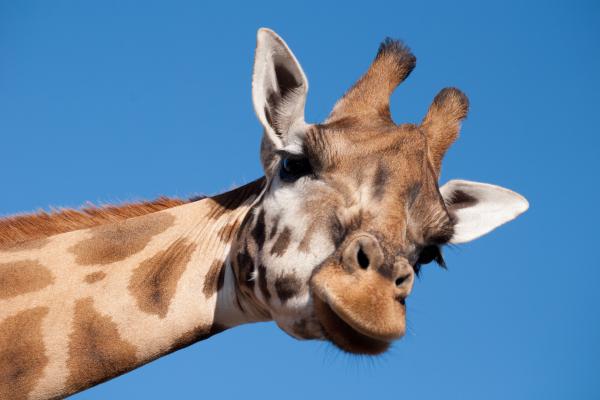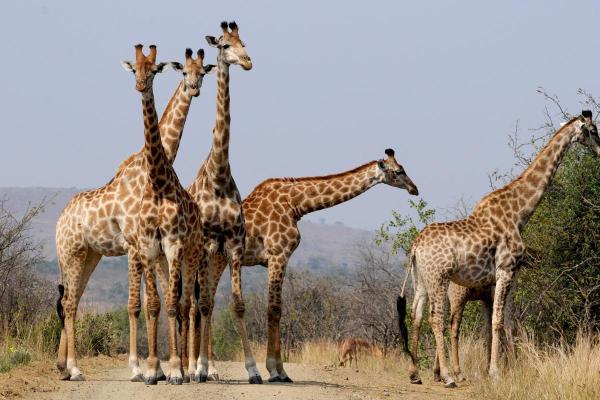How Long Do Giraffes Live?


The giraffe, the tallest land mammals on Earth, has a life influenced by its environment and unique adaptations. They are born after falling almost 2 meters to the ground and grow to a height of up to 5.5 meters (18 feet), going through interesting changes as they develop. The big difference in lifespan between wild and captive giraffes shows the many risks they encounter in the wild and the benefits, along with the challenges, of being protected by humans.
In this AnimalWised article we will explore how long giraffes live, what influences their longevity, and how they survive in different environments.
Life cycle of giraffes
Pregnancy and birth:
When a giraffe begins life, it's already been developing for quite a long time. Female giraffes carry their young for 14-15 months, which is one of the longest pregnancies of any land mammal. When the time comes to give birth, the mother remains standing, and her calf drops nearly 2 meters (6.6 feet) to the ground.
This dramatic entrance serves a purpose because the impact helps rupture the amniotic sac and stimulates the newborn to take its first breath.
Despite this rough start, newborn giraffes are capable. Weighing between 50-70 kg (110-154 pounds) and standing about 1.8 meters (5.9 feet) tall, they can typically stand within an hour and run within just 10 hours. This rapid development is essential for survival, as predators pose a threat to young calves.
Calf stage:
During the first few weeks of life, giraffe calves often hide in tall grass for protection. They initially rely entirely on their mother's milk, but by the time they're a month old, they begin sampling vegetation while continuing to nurse for 6-12 months.
An aspect of giraffe society emerges during this period. Mothers form "nurseries" where they take turns watching the young, allowing other mothers to feed. This cooperative care improves survival chances, though only about 25-50% of calves make it through their first year.
Adolescence and sexual maturity:
As they grow, young giraffes develop rapidly, sometimes gaining an inch in height daily. Females reach sexual maturity around 3-4 years of age, while males develop later, typically at 4-6 years. This delay gives male giraffes more time to grow and develop the strength needed for competition.
Adulthood:
In adulthood, male giraffes can reach heights of up to 5.5 meters (18 feet), with females typically growing to about 4.5 meters (14.8 feet). Males, weighing between 800-1,400 kg (1,764-3,086 pounds), engage in a behavior called "necking", which is a form of combat where they swing their necks to strike opponents. These contests determine dominance and mating rights but can lead to injuries that may reduce male lifespans compared to females.
Female giraffes can reproduce throughout adulthood, typically giving birth to a single calf every 15-20 months. The social structure of giraffe herds is flexible, with individuals joining or leaving groups of 10-20 animals as circumstances change.
Giraffes, as they get older, deal with typical aging issues. Their teeth wear down, making it tough to eat, and arthritis limits how well they can move. This tooth damage often results in starvation. Also, arthritis and joint trouble make it harder for older giraffes to move around, which means finding food and getting away from predators becomes a struggle.
Want to know more about giraffe anatomy? Read our article about why giraffes developed their distinctive long necks.

How long do giraffes live in the wild?
Giraffes in the wild have shorter lifespans than those in captivity due to numerous challenges they face. While their potential lifespan in the wild is about 20 to 25 years under ideal conditions, most giraffes don't live beyond 15 to 18 years due to various threats.
There's a notable gender difference in longevity. Females tend to live longer, sometimes reaching up to 25 years, while males rarely survive beyond 20 years. This difference is largely due to the physical risks associated with territorial battles and "necking" contests that males engage in for dominance.
Giraffes in their natural habitat face several hurdles that shorten their lifespan.
First up is predation. Lions are the big threat, usually going after the young, the old, or those not at their strongest. Hyenas and crocs also hunt the youngsters. That first year is super risky, with less than half of the calves making it to adulthood.
Then there's disease. Giraffes aren't immune to getting sick. Parasites like ticks and flies can be a nuisance, and outbreaks of diseases like rinderpest, anthrax, and tuberculosis can really hit populations hard. Without any medical help, these illnesses are often fatal.
Environmental challenges also play a big role. Things like drought mean less food and water, leading to malnutrition and dehydration. These harsh weather events can be especially deadly when they're severe.
Finally, there are human-related threats, and these are becoming a bigger problem. Habitat loss from farming and land turning into desert shrinks the areas where giraffes can find food and water. And while they're not poached as much as elephants or rhinos, giraffes are still hunted illegally in some places for their meat, skin, and tails.
What is the main cause of death of giraffes?
In the wild, predation is the primary cause of death for young giraffes, with lions being their main predators. Studies indicate that up to 75% of giraffe calves don't survive their first year largely due to predation. Adult giraffes are less vulnerable, but weakened, or elderly individuals remain at risk from lion prides.
For adult giraffes in the wild, disease and malnutrition become increasingly significant causes of death. As they age, dental wear severely impacts their ability to feed effectively. This dental deterioration often leads to malnutrition and eventually starvation. Various diseases including anthrax, tuberculosis, and parasitic infections also take a considerable toll on wild populations.
Did you know giraffes have one of the most distinctive tongues in the animal kingdom? Learn about this unique adaptation in our related article.

How long do giraffes live in captivity?
In captivity, giraffes typically enjoy significantly longer lifespans compared to their wild counterparts. With proper care in zoos and protected reserves, giraffes can live up to 30 years or more, with exceptional individuals reaching 35 years.
Several factors contribute to this extended lifespan in captivity:
- Controlled, balanced diets with vitamin and mineral supplements that prevent nutritional deficiencies.
- Regular veterinary care, including antiparasitic treatments, vaccines, and surgical interventions when needed.
- Complete protection from natural predators like lions and hyenas, significantly reducing stress.
- Consistent access to food and water without seasonal scarcity.
- Protection from environmental extremes and harsh weather conditions.
- Medical intervention for age-related conditions.
However, captivity also presents its own set of challenges for giraffes. Obesity and joint problems frequently develop due to limited movement opportunities and sometimes overly caloric diets. These conditions often lead to arthritis and various metabolic diseases as they age.
The stress of confinement in spaces that are typically much smaller than their natural range can take a psychological toll on these animals that would normally roam across vast territories. This spatial restriction, combined with a lack of natural stimulation, can negatively affect their behavior and overall well-being.
Reproductive issues are also common in captive giraffe populations, with some individuals experiencing difficulty breeding due to stress or genetic incompatibilities within the limited breeding groups available in zoos.
These challenges represent the trade-offs that come with the protection and care provided in captive environments, highlighting that although captivity extends lifespan significantly, it doesn't necessarily replicate all aspects of a natural and fulfilling giraffe existence.
How long did the oldest giraffe live?
The longevity record appears to be held by a giraffe at a Texas zoo that lived to an impressive 39 years of age.
Did you know giraffes have their own complex language systems despite being relatively quiet animals? Learn about their unique communication methods in our related article.
If you want to read similar articles to How Long Do Giraffes Live?, we recommend you visit our Facts about the animal kingdom category.
- Bercovitch, FB, & Berry, PS (2017). Life expectancy, maximum longevity and lifetime reproductive success in female Thornicroft's giraffe in Zambia . African Journal of Ecology, 55(4), 443-450.
- Berry, P.S.M., & Bercovitch, F.B. (2012). Darkening coat color reveals life history and life expectancy of male T hornicroft's giraffes . Journal of Zoology, 287(3), 157-160.
- Bond, ML, Lee, DE, Farine, DR, Ozgul, A., & König, B. (2021). Sociability increases survival of adult female giraffes . Proceedings of the Royal Society B, 288(1944), 20202770.
- Bond, M.L., Lee, D.E., Ozgul, A., Farine, D.R., & König, B. (2021). Leaving by staying: Social dispersal in giraffes . Journal of Animal Ecology, 90(12), 2755-2766.
- Müller, D.W., Bingaman Lackey, L., Streich, W.J., Fickel, J., Hatt, J.M., & Clauss, M. (2011). How to measure husbandry success? The life expectancy of zoo ruminants . WAZA Magazine, (12), 37-39.







